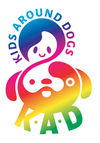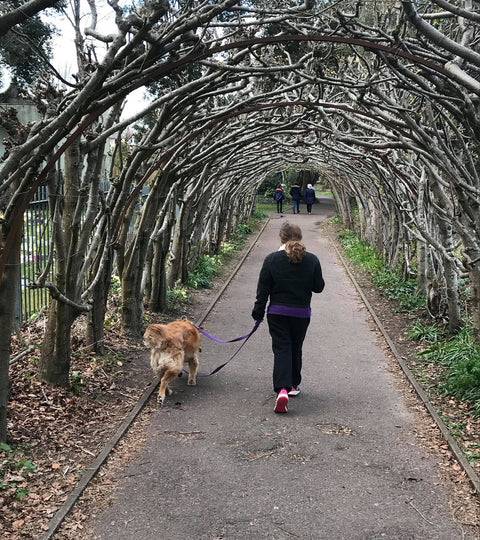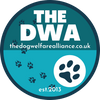How To Help Your Reactive Dog
You are out on a walk, dreaming of decorating the perfect nursery for your baby-to-come, when suddenly your dog is growling and then launching towards another dog… and you’re reminded, in a very stressful way, that your dog’s problems need to be addressed before the baby arrives.

Let’s talk about why your dog is reactive, shall we?
The reasons behind your dog’s strong feelings towards something in the environment could be many, however, we can categorise them as:
-
Health: your dog might have some underlying health conditions which cause him pain and is, therefore, more irritable towards the environment and less tolerable of others around him.
-
Fear: your dog might be scared of other dogs, or of certain characteristics other dogs have (such as big dogs, small dogs, a particular breed or colour, etc.); your dog might be worried about certain type of people (men; people wearing big hats; people carrying bags; etc.); or they might be frightened by loud noises (motorbikes; trains; people screaming; etc.); he could be worried by certain smells (a particular perfume; or the scent of a wild animal; and so on).
-
Overexcitement: when a dog, especially a young one or a particularly active one, he might want to have his nose and paws into everything; say ‘hello’ to everyone and anyone.
-
Socialisation: this would be a case of not having prepared your dog for the world by socialising him appropriately from the start; or having over-socialised him by overwhelming him with stuff.
In this post, I aim to give you some suggestions for each of the possible reasons above.

HEALTH:
You might have heard this before, but dogs are very resilient to pain. I lost count of the times my husband and I have accidently stepped on my pug Wilco’s paws (so so sorry Wilco!! But, gosh, he’s like a ninja: moves up to one of us every so quietly!). When that happens, little Wilco makes the most heart-breaking high-pitched bark, which sounds more like a squeak; then shake it off and walks away as if nothing happened, while I trail behind him profusely apologising, thinking he’s probably got a broken paw. He then normally comes to me right away because he knows I’ll give him the content of the fridge, out of complete guilt for having hurt him. He always seems super happy about it too. Is he still in pain? Yes, most likely he is. After all, a considerable amount of pressure had been put on his paw, that’s got to hurt! If that’d happened to us, we would have been on the floor complaining for ages about the pain and we would have milked it for all its worth!
Dogs, on the other hand, aren’t like that… they take it on the chin and endure it all so bravely.
Therefore, pain of any kind can’t be excluded and the only way to be certain, is for your vet to check your dog properly, before moving on to behavioural modifications.
A Dog Behaviourist would ask for your dog’s medical history and the vet referral, before taking on your case.

FEAR:
When a dog is scared, he might hide behind his trusted human, or under a table, or anywhere where he feels he can disappear. His demeaner would change too: his ears might be pinned back, his body would be crouched down, his head would be turned away from the object of his fear. Those are some of the signals that a dog might give when his fear is great and his way of dealing with it is by not confronting it.
You might also have a totally different reaction, which would be that the dog would tense up and bark, growl, launch and more towards the object of his fear, to make it go away. This type of reaction is much stronger than the first one, and, sadly, works better, that’s why we need to listen to our dogs, read their body language and understand when to get them out of a situation they don’t want to be in, BEFORE they feel like they have to get to a point of pushing the ‘scary thing’ away in such strong manner.
Dogs have a way of communicating with the world through their body, being able to read their body language is essential in preventing nasty situations from occurring.
Dogs don’t mean to fight, however, if put in a situation where they see no way out and they feel extremely threatened, they will find a way to defend themselves. Therefore, make sure to never push your dog to do what he doesn’t want to do: don’t make him be friend with your neighbour’s puppy, they can co-exist without having to interact all the time.
Also, don’t push him to meet children who are running and jumping all over the place: we need to teach our kids to respect our dogs and to be calmer around animals; and to give our dog time to decide if he wants to interact or not and, if he doesn’t, we ought to respect the dog’s decision. After all, we also don’t always want to be hugged and kissed all of the time, do we?
Why not training the dog to have a default behaviour when things get difficult for him to handle? I love the ‘Peekaboo’ (also called ‘Middle’) for small to medium size dogs; while I use ‘With me’ (also called ‘Side’) for bigger dogs.

OVEREXCITMENT:
When you’re young and full of beans, life is exciting and fun and and and… wow, and breathe!
The first thing I would like to consider is: can I take my dog somewhere less exciting?
Can you go for a walk somewhere less busy? Or at a different time of the day, when there are less people around? Can you avoid to bring your dog to the school run, especially at pick up, when the kids are more excited and it is generally more crowed?
Trying to reduce the triggers can really help you dog!
The world is full of interesting things: birds flying, squirrels running, children playing, bicycles going passed so quickly, a people cuddling dogs and other dogs wanting to play and tennis balls that need chasing and and and… oh goodness, just take a breath!
Taking a deep breath helps to lower your heart rate, it realises endorphins, making you feel calmer. This works for dogs too!
Why not training your dog to take a deep breath?

SOCIALISATION:
I believe socialisation is one of the most misunderstood things humans do with dogs. For some reasons, some people believe that dogs shouldn’t see anything or anyone until they are fully vaccinated, which could be until there are 12 or 14 weeks old (at best); then, when the time comes, they take their puppy to meet a group of a million other dogs, throw them in such chaotic situation and smile thinking their puppy is having a great time. Meanwhile, the poor pup is having to deal with emotions and situations he doesn’t know and doesn’t understand and can’t handle.
And then, they take the puppy to the school run, when it’s super busy and kids run around excited to be finishing school, or to see their friends, and find it difficult to control themselves. Once again, the owner steps back and watch with delight as the puppy is being surrounded by excited children who think he’s the cutest creature in the world and so fluffy and so funny.
Little does he know; the puppy is probably uncomfortable and asking for some time to process what’s happening.
The dog might show different type of body language: he might freeze into place, waiting for all that chaos to stop; he might lick his lips; look away and even try to back away; shake off; pant; close his eyes. The list goes on.
All these signals are there to tell us, and the whole world, that the dog can’t handle that situation. The dog needs space and time to process it all and to make the decision to either join in or back away.
Often, however, the dog might appear to be joining in the crazy, by jumping up and goof around: This can be a sign of feeling uncomfortable too.
It can also be something called emotional contagion, where the dog ‘read the room’ and acts accordingly (for example, if everyone is happy and laughing, he’d get up and be happy and excited too).
Once again, reading your dog’s body language is important and useful.
When thinking about socialising your dog, think ‘little and often’ and keep the meetings with other dogs or people or vehicles, etc short and sweet.
Also, make sure you take him out from the start: Why not using a sling to carry your puppy? (If he falls asleep, don’t wake him up! Sleeping is important and he’s still taking the world in, just in a different way).
Don’t force your puppy to interact with another dog or a child, if he doesn’t want to.
Use treats and loving words to reinforce calming behaviours from your puppy.
If your puppy acts in ways you don’t like, make sure not to tell him off, as that could make matter worse. Redirect him towards you and take him away from the situation. Most likely, things just got too difficult for him to handle (which also means he was pushed too much… take a step or two back and make it easier for him).
Remember: while I appreciate you reading my blog, it will never substitute the help of a qualified trainer or behaviourist that would get to know your dog personally. Every dog is different, so it’s the protocol to help overcoming their issues.
Get in touch with your local KAD Approved Trainers to assist and work with you and your dog.

Credit: Video of Moo demoing taking a breath, from KAD Approved Trainer Freya Locke at Locke’s Dogs – Behaviourist & Trainer, Fun Not Fear











0 Comments
There are no comments yet. Be the first one to post one!